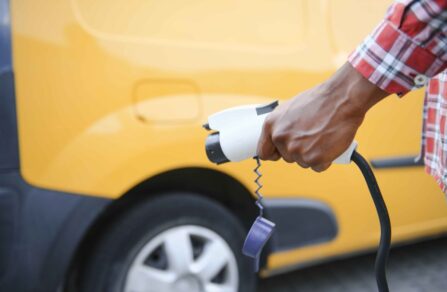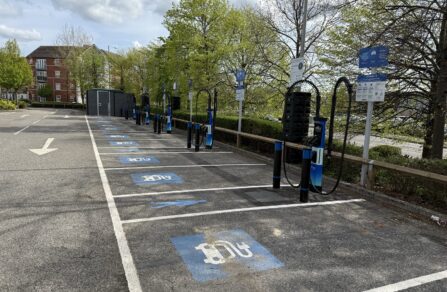
Ask the Experts: How Does Mer Handle the EV Charger Installation Process?
In this series of articles we take the time to sit down with memb...

The electric car (EV) revolution is not slowing down. As of April 2025, there are over 1.5 million fully electric cars in the UK. This represents 4.4% of the 34 million cars on UK roads, and is up from 1.2% at the end of 2021. If we count Plug-in Hybrid Vehicles (PHEVs) as of April 2025, this figure jumps to 2.3 million, or around 6.5%.
At the end of 2024, there were an estimated 1 million home charge points in the UK, but for the estimated 32.8% of households with no driveway, this represents a problem. Around 20% of EV drivers don’t have access to a home charger.
So, what does it mean for them? Fortunately, there are alternatives to EV charging with no driveway, such as on-street public or workplace chargers. This guide explores your options.
Naturally, the most obvious solution for those without driveway parking is to charge on the public network instead.
According to the latest Zap Map data from April 2025, there are now 79,654 public charging points across 39,427 locations in the country. This represents a 30% YoY growth.
Rapid and ultra rapid devices have increased at a particularly high rate, with a YoY increase of 33% for April 2025. If we look at ultra rapid chargers alone, the figure stands at 58% YoY.
Broken down by speed, the UK public charging network consists of:
Availability does differ significantly depending on where you live in the country however. And at present, Greater London has the most charging points by far, with over 23,000, followed by the South East (10,122) and then West Midlands (7,361). By comparison, Northern Ireland has the least with just 659, below the North East (2,535) and the East Midlands (3,367).
Rapid or ultra rapid charging now makes up 61.6% of the total public utilisation in the UK. Low-powered charge points are used less than once a day on average, but for an average duration of 4 hours, whereas 50kW+ chargers are used on average around 4 times per day, but for a session duration of roughly 40 minutes.
To facilitate inclusive, widespread EV adoption, a continued and cohesive effort from both local authorities and businesses alike is needed.
We will need to see even more electric charge points installed in publicly accessible locations, ideally in spots where drivers can occupy themselves elsewhere while their vehicle charges. Workplaces, residential areas (particularly those with a lack of off-street parking), council owned car parks, and retail parks, are all ideal spots for drivers to park up and charge.

We have seen a huge investment (partially due to the Rapid Charging Fund) in the development of rapid charging infrastructure over the last few years. EV charging companies are also investing, as most of them offer a fully funded solution to local authorities and retail site owners. However, it is mainly happening in out-of-town locations, such as motorway services, catering to those charging on longer journeys. And once you move further into the cities, the most common type of chargers are still fast AC chargers.
There will likely always be a need for fast chargers, for those wishing to charge on the street overnight, when they aren’t in a rush. But, as the average battery range of EVs increases, there is now a focus on the range added per minute of charging time. And people need the flexibility and convenience of rapid and ultra rapid charging in the city, particularly those without driveway access.
As part of this, the UK Government has a range of funding schemes to help local authorities install and upgrade their charging infrastructure.
The On-Street Residential Chargepoint Scheme (ORCS) provides funding towards the costs of installing public charging infrastructure for residents with no access to private parking. This can include both on-street and local residential car parks.
The Local EV Infrastructure Fund (LEVI) helps local authorities use private sector investment for their local charging networks to develop long-term, sustainable charging infrastructure.
Additionally, the government also offers incentives to install workplace EV charging infrastructure.
Naturally, given that many of us spend large periods during the week at work, they are an ideal charging point location for those without driveaway access.
Businesses can claim a workplace EV charging grant from The Office for Zero Emission Vehicles (OZEV) entitling them to £350 off per charge point socket up to a total of 40 sockets. And there’s a whole host of added benefits of providing EV charging for employees, including increased retention and talent attraction.
In support of such efforts, Mer recently signed an agreement with workspace owner Regus to provide charging to employees and guests of Regus.

Alongside the growth of public charging networks, we’re witnessing lots of technological innovation around how we charge. This includes taking advantage of existing energy sources in unique ways and changing the way we get the energy into the vehicle altogether. Such options make life easier for EV owners without driveways.
Developments and improvements to the vehicles themselves mean it’s never been easier to own an EV. In fact, many models now have built-in charging station guidance.
App developments are making the process easier, too. ZapMap has long been a reliable source for most EV drivers in locating a charge point. And the service is integrated with Apple CarPlay and Android Auto to offer a subscription service beyond their standard free charger search, plan and pay functionality.
ZapMap Plus enables drivers to filter by new charge points, multiple locations, user ratings, detailed location types, view new chargers installed in the last 30 days, save more user filters and route plans, and add multiple vehicles.
Google Maps is also now set up to make EV drivers’ lives easier. Exactly what you’ll have access to will depend on the car model, but features include estimated battery level on arrival at the destination you’ve typed into Maps.
Charging Assistance is also available, with charging stations mapped on your route. Also, you can search for charging stations, filtering your results by charger types, payment networks and charging speeds. Drivers can add charging stations to their route and even view a recommended minimum charging time.
It’s never been easier for EV drivers to locate, charge and pay on the public network. But the pace of change still may not be fast enough to keep up with the rate of EV purchase growth and support those without driveway charging.
There needs to be a combined effort from public and private bodies alike to support the transition.
Sources
1 https://www.zap-map.com/ev-stats/ev-market
2 https://www.zap-map.com/ev-stats/home-and-community-charging
3 https://www.zap-map.com/ev-stats/how-many-charging-points
4 https://www.zap-map.com/ev-stats/charging-utilisation-stats
5 https://www.fastcharge.email/p/survey-are-lamppost-ev-chargers-often
6 https://evpowered.co.uk/opinion/how-lampposts-can-light-up-the-uks-ev-charging-network/

In this series of articles we take the time to sit down with memb...

Discover the UK government’s 2025 new incentives for EV fleets, i...

The changing face of retail parks is helping them stay relevant f...